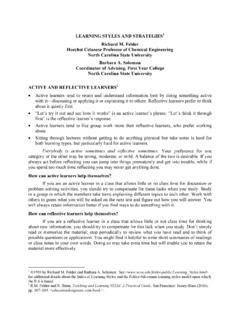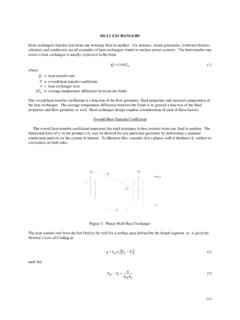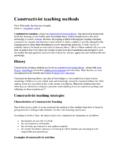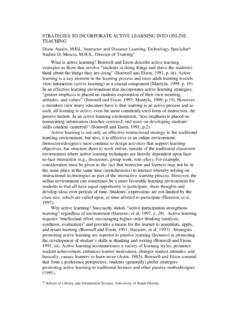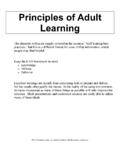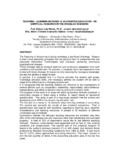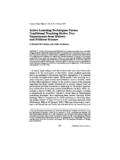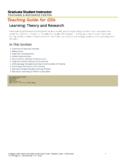Transcription of Does Active Learning Work? A Review of the Research
1 July 2004 Journal of Engineering Education1 MICHAELPRINCED epartment of Chemical EngineeringBucknell UniversityABSTRACTThis study examines the evidence for the effectiveness of activelearning. It defines the common forms of Active Learning mostrelevant for engineering faculty and critically examines the coreelement of each method. It is found that there is broad butuneven support for the core elements of Active , collaborative,cooperative and problem-based Learning . I. INTRODUCTIONA ctive Learning has received considerable attention over thepast several years. Often presented or perceived as a radical changefrom traditional instruction, the topic frequently polarizes Learning has attracted strong advocates among faculty look-ing for alternatives to traditional teaching methods, while skepticalfaculty regard Active Learning as another in a long line of educa-tional fads.
2 For many faculty there remain questions about what activelearning is and how it differs from traditional engineering educa-tion, since this is already Active through homework assignmentsand laboratories. Adding to the confusion, engineering faculty donot always understand how the common forms of Active learningdiffer from each other and most engineering faculty are not inclinedto comb the educational literature for answers. This study addresses each of these issues. First, it defines activelearning and distinguishes the different types of Active learningmost frequently discussed in the engineering literature. A core ele-ment is identified for each of these separate methods in order to dif-ferentiate between them, as well as to aid in the subsequent analysisof their effectiveness. Second, the study provides an overview of rel-evant cautions for the reader trying to draw quick conclusions onthe effectiveness of Active Learning from the educational , it assists engineering faculty by summarizing some of themost relevant literature in the field of Active Learning .
3 II. DEFINITIONSIt is not possible to provide universally accepted definitions forall of the vocabulary of Active Learning since different authors in thefield have interpreted some terms differently. However, it is possi-ble to provide some generally accepted definitions and to highlightdistinctions in how common terms are used. Active learningis generally defined as any instructional methodthat engages students in the Learning process. In short, Active learn-ing requires students to do meaningful Learning activities and thinkabout what they are doing [1]. While this definition could includetraditional activities such as homework, in practice Active learningrefers to activities that are introduced into the classroom. The coreelements of Active Learning are student activity and engagement inthe Learning process. Active Learning is often contrasted to the tra-ditional lecture where students passively receive information fromthe instructor.
4 Collaborative learningcan refer to any instructional method inwhich students work together in small groups toward a common goal[2]. As such, collaborative Learning can be viewed as encompassing allgroup-based instructional methods, including cooperative Learning [3 7]. In contrast, some authors distinguish between collaborativeand cooperative Learning as having distinct historical developmentsand different philosophical roots [8 10]. In either interpretation, thecore element of collaborative Learning is the emphasis on student in-teractions rather than on Learning as a solitary activity. Cooperative learningcan be defined as a structured form of groupwork where students pursue common goals while being assessed in-dividually [3, 11]. The most common model of cooperative learn-ing found in the engineering literature is that of Johnson, Johnsonand Smith [12, 13].
5 This model incorporates five specific tenets,which are individual accountability, mutual interdependence, face-to-face promotive interaction, appropriate practice of interpersonalskills, and regular self-assessment of team functioning. While dif-ferent cooperative Learning models exist [14, 15], the core elementheld in common is a focus on cooperative incentives rather thancompetition to promote Learning . Problem-based Learning (PBL) is an instructional method whererelevant problems are introduced at the beginning of the instructioncycle and used to provide the context and motivation for the learn-ing that follows. It is always Active and usually (but not necessarily)collaborative or cooperative using the above definitions. PBL typi-cally involves significant amounts of self-directed Learning on thepart of the students.
6 III. COMMONPROBLEMSINTERPRETING THELITERATURE ONACTIVELEARNINGB efore examining the literature to analyze the effectiveness ofeach approach, it is worth highlighting common problems that en-gineering faculty should appreciate before attempting to draw con-clusions from the literature. A. Problems Defining What Is Being StudiedConfusion can result from reading the literature on the effec-tiveness of any instructional method unless the reader and authorDoes Active Learning Work? A Review of the Research [QA1]take care to specify preciselywhat is being examined. For example,there are many different approaches that go under the name ofproblem-based Learning [16]. These distinct approaches to PBLcan have as many differences as they have elements in common,making interpretation of the literature difficult.
7 In PBL, for exam-ple, students typically work in small teams to solve problems in aself-directed fashion. Looking at a number of meta-analyses [17],Norman and Schmidt [18] point out that having students work insmall teams has a positive effect on academic achievement whileself-directed Learning has a slight negative effect on academicachievement. If PBL includes both of these elements and one asks ifPBL works for promoting academic achievement, the answer seemsto be that parts of it do and parts of it do not. Since different appli-cations of PBL will emphasize different components, the literatureresults on the overall effectiveness of PBL are bound to be confus-ing unless one takes care to specify what is being examined. This iseven truer of the more broadly defined approaches of Active or col-laborative Learning , which encompass very distinct practices.
8 Note that this point sheds a different light on some of the avail-able meta-analyses that are naturally attractive to a reader hopingfor a quick overview of the field. In looking for a general sense ofwhether an approach like problem-based Learning works, nothingseems as attractive as a meta-analysis that brings together the resultsof several studies and quantitatively examines the impact of the ap-proach. While this has value, there are pitfalls. Aggregating the re-sults of several studies on the effectiveness of PBL can be mislead-ing if the forms of PBL vary significantly in each of the individualstudies included in the meta-analysis. To minimize this problem, the analysis presented in Section IVof this paper focuses on the specific core elements of a given instruc-tional method. For example, as discussed in Section II, the core ele-ment of collaborative Learning is working in groups rather thanworking individually.
9 Similarly, the core element of cooperativelearning is cooperation rather than competition. These distinctionscan be examined without ambiguity. Furthermore, focusing on thecore element of Active Learning methods allows a broad field to betreated concisely. B. Problems Measuring What Works Just as every instructional method consists of more than one ele-ment, it also affects more than one Learning outcome [18]. Whenasking whether Active Learning works, the broad range of out-comes should be considered such as measures of factual knowledge,relevant skills and student attitudes, and pragmatic items as studentretention in academic programs. However, solid data on how an in-structional method impacts all of these Learning outcomes is oftennot available, making comprehensive assessment difficult. In addi-tion, where data on multiple Learning outcomes exists it can includemixed results.
10 For example, some studies on problem-based learn-ing with medical students [19, 20] suggest that clinical performanceis slightly enhanced while performance on standardized exams de-clines slightly. In cases like this, whether an approach works is amatter of interpretation and both proponents and detractors cancomfortably hold different views. Another significant problem with assessment is that many rele-vant Learning outcomes are simply difficult to measure. This is par-ticularly true for some of the higher level Learning outcomes that aretargeted by Active Learning methods. For example, PBL might nat-urally attract instructors interested in developing their students ability to solve open-ended problems or engage in life-long learn-ing, since PBL typically provides practice in both skills.
